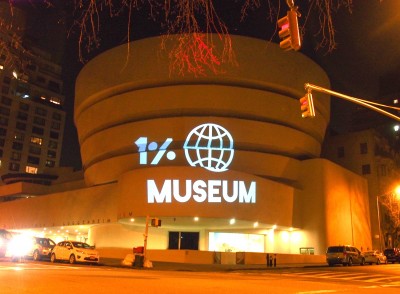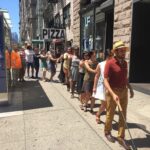Editorial | Spring 2016
Grant Kester
The May 2016 announcement of “Guggenheim Social Practice,” a new initiative which will commission two “socially engaged art” projects that “engage community participants…. and foster new forms of public engagement,” is only the most recent example of a major art museum jumping on the social art practice bandwagon.[1] “Guggenheim Social Practice” is being funded by the Edmond de Rothschild Foundation, which is the philanthropic arm of Edmond de Rothschild Investment Partners, a private banking and asset management firm in France owned by members of the Rothschild banking dynasty. On it’s website the Rothschild Foundation professes it’s dedication to “social entrepreneurship” (a neo-liberal catch phrase that signals its support for projects that seek to imbue the poor with a properly bourgeois commitment to economic self-actualization, and which implies, by extension, that their poverty is the product of a certain lack of entrepreneurial zeal). Not surprisingly, the same language is reproduced on the Rothschild Investment website, which praises the virtues of risk-taking “entrepreneurs and investors”.
The Guggenheim’s announcement is symptomatic of an interesting shift in the institutional discourse of contemporary art. Museums that for many decades strenuously resisted any programming that would foreground the interconnection between artistic production and social change have, belatedly, begun to acknowledge the tectonic shift that has occurred in contemporary art over the past two decades. In an effort to appear relevant they are now being forced to rapidly calibrate the relationship between their own institutional agendas (typically concerned with the prerogatives of individual and corporate wealth and prestige, massaging the egos of rich collectors, and vague notions of the “public”) and the imperative to challenge the easy affiliation of wealth, privilege and art, which is the implicit foundation of many socially engaged art practices. At the same time, the leading role taken by the Guggenheim’s Education department in this initiative (consistent with the firewalling we’ve seen at MoMA), suggests that some boundaries still can’t be crossed; in particular the institutional blood/brain barrier between Education and Curatorial departments.
The timing of the Guggenheim’s announcement is particularly revealing. It came only a few weeks after the museum decided to break off negotiations with the Gulf Labor Coalition [GLC] in April 2016.[2] The Gulf Labor Coalition consists of artists, activists and scholars who have been working for the past six years to encourage the museum to adopt fair labor standards in the construction of a new Guggenheim branch in Abu Dhabi. The GLC has conducted an enormous amount of research into labor practices in Abu Dhabi and international standards for the treatment of workers, and has struggled mightily to engage the Guggenheim in a dialogue about ways to improve the labor conditions associated with the construction of its new museum. In this process it has formed a coalition of international labor and human rights organizations and stakeholders with a close understanding of the region. The process has proceeded by fits and starts, in large part due to the intransigence and delaying tactics of the museum, which only began to engage the GLC more fully following a series of demonstrations at the Peggy Guggenheim Collection in Venice and the New York Guggenheim in May 2015. The Guggenheim’s decision to preemptively end these ongoing negotiations suggests that the museum has determined that the negative publicity created by further demonstrations (which seem likely) is a reasonable price to pay for the money they will save by subjecting workers to unsafe and inhumane labor conditions.
While it’s likely that the Guggenheim’s new social art practice initiative has been in the planning stages for some time, and wasn’t necessarily intended to serve as a form of promotional counter-programming that would demonstrate the museum’s commitment to social justice and “dialogue,” the coincidence of these two events does point to one of the key tactical issues that will emerge as more mainstream arts institutions stumble into the contested terrain of socially engaged art. Modern art has always been defined by two interrelated modalities: the desire for solidarity and reconciliation and the imperative of resistance and critique. For much of its recent history resistance was produced through a process of virtual negation, in which art ritualistically assaulted the consciousness of an imaginary viewer who stood as a representative of the forces of bourgeois reaction. Alternately, negation was produced as art sought to differentiate itself from some internalized principle of difference (the ‘inherent’ constraints of a specific medium or the category of ‘not-art’ consisting variously of kitsch, propaganda, theatrical performance, or activist art itself).
What differentiates contemporary socially engaged art is its decision to enact critique in specific, operational sites of resistance. Negation is no longer staged against an imaginary interlocutor who can never answer back, but through a dialogical exchange in which the space of resistance and the social actors mobilized in this space, respond and react in real time. This non-virtual resistance suggests an understanding of the social and the public that most museums will find difficult to swallow, to the extent that they exist as calcified institutional forms accreted over decades of close interaction between the rich and the cultured, and to the extent that they operate through a set of internalized norms that will tolerate dissent within only a very narrow bandwidth. Every institution, of course, exerts its own framing influence and is defined by both constraints and possibilities. At the same time, it would be naïve to assume that the symbolic freedom associated with modern art, over a long history of movements that by and large saw their role as unsettling established institutions, renders the space of the museum any more neutral or accommodating to forms of social transgression or critique. Socially engaged art can serve as “social grease,” to use Hans Haacke’s apt formulation, just as easily as Rembrandt canvases or Donald Judd boxes have in the past. And it should come as no surprise that arts institutions are just as capable of coopting dissent as governmental agencies.
In this issue . . .
FIELD #4 features an essay by artist Angela Washko reflecting on a performance-based project she developed involving a conversation with the notorious on-line misogynist Roosh V. Roosh lives with his mother in the suburbs of Washington, D.C., and has created an on-line persona that operates in a modality more familiar to us from right wing talk radio; he is an empowered, but ultimately victimized, male lamenting the decline of his natural privilege and engaging in compensatory attacks on the imagined authors of his disempowerment. Roosh’s innovation was to bring this persona to bear on issues of sexuality in particular, as the leading exponent of a ‘Pick up’ culture that views any heterosexual interaction as a kind of zero sum game, in which the male wins by optimizing his sexual exploitation of the female. In response to past criticisms Roosh has encouraged his followers to engage in on-line attacks on his critics, including doxing (releasing their personal information on-line). Roosh’s endorsement of rape “on private property” in a February 2015 blog post led to a broad backlash against his “Return of Kings” meet-ups, and numerous on-line attacks, including being doxxed in turn by Anonymous. This all transpired after Washko’s interactions with Roosh, which are documented in her FIELD essay. We are grateful to her for allowing us to publish it here, as this is not without potential risk.
The work of the Gulf Labor Coalition discussed above is also featured in Greg Sholette’s response to an essay by critic Boris Groys, originally published in e-flux journal, which critiques the recent proliferation of “activist art”. Here Sholette addresses the curious uneasiness produced in academic scholars by the categorical slippage that can often occur between art and activism, especially as a result of the broader re-framing of aesthetic autonomy that has emerged over the past two decades in contemporary art. At the basis of Groys’ critique is a prototypical feature of the modernist avant-garde, which carries along with it the faint echoes of Kantian disinterest, even to the present day. Aesthetic experience, in order to be suitably transformative, must occur only within the sequestered space of the individual consciousness. Anything that occurs beyond the “realm of semblance alone,” as Schiller wrote, will suffer an inevitable corruption. While the modality of this transformation has long ago shifted from a prefigurative transcendence (of self and other) to a compensatory disruption (intended precisely to block or deny transcendence) the broader schema of aesthetic autonomy remains largely intact. Drawing on his own long history in the area of socially engaged art, as well as a selection of diverse examples of recent practice, Sholette offers an alternative analysis of the remarkable growth of activist art.
Issue #4 also features a conversation between Kevin Ryan, a sociologist teaching at the National University of Ireland at Galway, and Fiona Whelan, an artist who teaches at the National College of Art and Design in Dublin. Ryan and Whelan explore the vicissitudes of the community art tradition in Ireland more broadly, and the specific operation of Whelan’s Rialto Youth Project, which she has run over the past twelve years. They focus here on the contradictions posed by the “professionalization” of community art practice that emerged in Ireland, and in other countries in the UK and Europe, during the 1990s in conjunction with efforts to undermine existing forms of social provision. The U.S. underwent its own version of this during the 1980s and ‘90s as part of a general Republican attack on welfare. Ryan and Whelan link the bureaucratization of community art in Ireland to the normalizing mechanisms of neo-liberal public policy, and ask what forms of agency or contestation might be still be possible given the constraints of this broader political context.
We are pleased to present another Re-Post essay in this issue by Christoph Schäfer, who, along with Margit Czenki, is a key figure in the Park Fiction project in Hamburg, Germany. Schäfer’s essay, “Bostanorama,” is based on his research in Istanbul shortly after the Gezi Park uprisings. He discerned a number of interesting interconnections between the form taken by protests over public space in Istanbul and his own experiences with the process of creating Park Fiction in Hamburg, especially as they relate to the complex cultural practices generated by protests, occupations and demonstrations. Schäfer contends that artists and activists globally have much to learn from the experiences of Gezi Park, which functioned as a kind of laboratory of resistance and creative dissent. His essay here presents a first-person account that captures something of the exuberant and improvisational energies of the occupation, while also grounding the situation of Gezi Park in the broader history of public space and urban gardens in Ottoman culture.
The question of paradigms and precedents returns again in Paloma Checa-Gismero’s review of Yates McKee’s Strike Art (Verso, 2016). While Checa-Gismero finds much of value in McKee’s finely honed study of the on-the-ground tactics of the Occupy Movement in New York, she also questions the somewhat heliocentric tendency to view Zuccotti Park as the germinal form of an occupation-based mode of resistance that was subsequently adopted more widely. The Arab Spring, of course, began nine months earlier, and occupation-based protests attacking privilege and corruption proliferated throughout Latin America and many other regions of the globe during the 1990s and early 2000s. OWS appears again in Izabel Galliera’s review of the Brooklyn Museum’s Agitprop exhibition, which attempts to unite a diverse body of activist art and cultural practice under the umbrella concept of “agitational propaganda.” The result is a somewhat ahistorical mélange of projects that range from Suffragette-era cartoons, to proto-feminist Soviet films, to Judy Chicago’s Dinner Party, to Occupy Wall Street, to the Yes Men and a number of other more recent works. As Galliera notes, the Brooklyn Museum itself has been caught up in a political controversy regarding its own role in the gentrification of Brooklyn. This is a tension that the museum attempted to address by incorporating a work by area activists who had been protesting outside the museum only a few weeks before the exhibition’s opening. This gesture returns us again to questions about the relationship of museums to socially engaged art, with which this editorial began. It returns us, as well, to issues of incorporation, cooption and critique that were explored in previous issues of FIELD by Sebastian Loewe (“When Protest Becomes Art: The Contradictory Transformations of the Occupy Movement at Documenta 13 and Berlin Biennale 7”) in FIELD Issue #1 and Noah Fischer (“Agency in a Zoo: The Occupy Movement’s Strategic Expansion to Art Institutions”) in FIELD Issue #2.
Notes
1. See: https://www.guggenheim.org/press-release/85742. Other examples include the Hammer Museum’s “Public Engagement” program in Los Angeles (one of the first of such programs, and one which employs a dedicated curator outside it’s Education Department) and the Museum of Modern Art’s “Artist’s Experiment” program in New York, which is based in their Education Department.
2. http://gulflabor.org/2016/gulf-labor-responds-to-guggenheim-breaking-off-negotiations/







